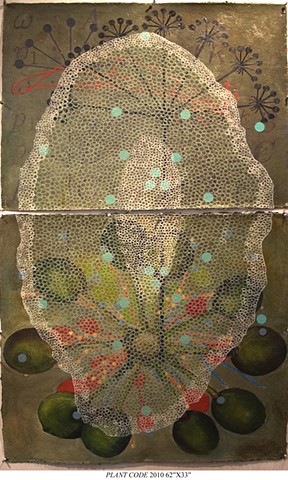A. COLLABORATIVE 2010-2011
It is the combination of the patterns of, Paper Plant-including the rhythmic patterns of seed pods plus –computer algorithms, Poison Ivy....
We used an algorithm as a visual element, combining algorithms w/ the plant organs...The paper plant is a plant we planted when we first moved here. We have presented it in this painting in a variety of steps and forms. We started it as it was going to seed – Then gradually it came back from frost bite – We photographed it as its leaves came back-...
The basic patterns of the “wheel form is from the seed pod. There is a time element here. Cycles- Behind and mid-way is the patterns of a patch of clover – A plant we found with the paper plant -also poison ivy- the root & the leaves—The diagrams are computer models for plant organs—leaves and petals – Umbels are characterized by more than 2 internodes attached to a single node. The math equation is for the partial L system for a simple umbel... The larger formula – (here in combination) is for a compound umbel of recursion depth 2- what does all this mean? Journal
Here is a list of plants either in direct form or in diagrammatic form including dots & patterns.
1. Seedpods on stack of Paper Plant – Several Versions.
2. clover – pattern with connective lines.
3. Paper Plant in dots,- circles.
4. Poison Ivy –Top – circle patterns.
5. Equation (umbels) see previous page
6. diagram of umbels
We use these formulas—or should I say the formulas and the diagrams – 3d modeling diagrams introduce the idea of a (synthetic) realm. Our dealings with the natural world has been reduced – our dealings with mathematical simulated processes that echo natural formations…[has increased]. Journal
